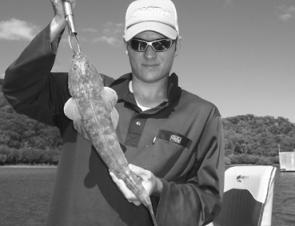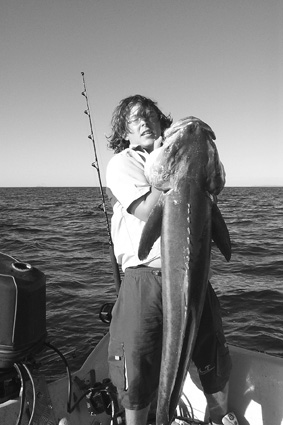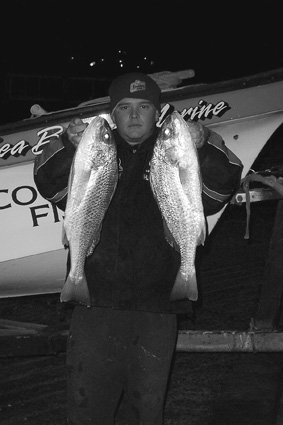August should be a bonanza month for pelagics in the Keppel Bay area.
We are currently getting an extraordinary out of season run of very large black king (cobia). These brilliant fighting fish usually come on in big numbers in the warmer months around Christmas and the only the odd fish is taken for the better part of the year. Last year we had exceptionally warm currents over the cold months and it affected most of the regular species in one way or another. The lesser mackerels seemed to hang in here much longer than normal but cobias were fairly scarce. Ocean temperatures in the bay have returned to that of an average year and still the cobes come.
Livebaiting is one of the most successful methods and using iodine bream and just legal hussar will almost guarantee a black king if there is any in the vicinity or at least a big Spanish mackerel as a welcome by-catch. The old WA pilly is another favourite of cobes particularly when they are in good condition. Try floating them down with a pea sinker placed directly above your gang hooks. Lures, whether you prefer minnows or chromies, have a place in the tackle box. Deep divers work the best of the minnows, with red head white body and blue or green pilchard type lures attracting their share of quality fish. Taipans, Raiders and Flashas can all take cobia when used in a quick erratic retrieve. I like to let the lure sink almost to the bottom before winding so the fish have longer to react before the lure reaches the boat.
My regular crew bought Luke McLennan from Orange in southern NSW who until now had only landed trout and red fish (I don’t think we would call them real fish in Queensland). His first and only keeper was a 20kg cobia on a small bait rod. With jeers coming from nearby boats and comments mentioning that we could have landed another four or five in the time it took to land he finally got it to gaff. As a rule we only keep one of these huge fish simply because they are too good to catch once and take up a lot of room in the esky. Luke is now pondering the move north when you can land fish like these within 30 minutes of home.
Mackerel numbers, mainly doggies and the early schools of spotties should hit the bay this month. The normal slowing of the southeasters gives the local waters a chance to clear up making it much more inviting to the travelling fish from bait to Spaniards and tuna. The westerlies may stop the bite for a while, except for the closer in areas under the wind curtain which hits the water roughly two thirds of the way to the islands. The better locations during the westerlies are Ironpot, Rita Mada, Farnborough, Corio Heads, Stockyard Point, Quartz Rock and Cape Manifold.
‘Golden grunter’ is another local name because of the yellow colour of the bigger fish. Grunter have continued to hold a position near the top of the local favourite feeds. Their delicate flesh and mild flavour appeal to all tastes and the size they are at present also makes them a fine catch.
When looking for grunter in the deeper waters, the known areas like The Barge, Cape Manifold, Cape Capricorn, The Rama and The Pinnacles are great starting points. Grunter like the same general area as black jew and often compete for the same rigs. Popular opinion is that despite the better fighting capabilities of the jewies, grunter are by far the better of the two as a table fish. The best place to try is over the rubble type patches and the trenches just away from the base of the bombies and pinnacles. Check the current flow and pick a drift pattern that keeps you in the zone longer until you find exactly where they are hanging and then anchor upstream.
The grunter have been a bit finicky latelly so use lighter sinkers and let down further back from the fish, this has done the trick. They have been a little hard to predict when and where except for the few days either side of the moon.
Black jew may not be quite as tasty as the grunter but there is a following of anglers who like jew for their different taste. Any deficiency in flavour is made up for with their fighting ability. In the shallow waters around our close in jew holes they fight like demons especially on the first run. Around the bombies and structures, jew can be dirty fighters so use a tough leader. They gather the same as grunter, around the moon. Schools of jewies circle round and round the area often biting on the way through then going quiet again until the pass on the next circuit. If there are a few boats fishing in the one spot you can hear the drags going in each of the boats as they come back. Jew will eat squid, pilchards and flesh baits particularly when they are juicy and fresh. Small live trevally and even tailor on the rare occasion they travel this far north make fantastic jew baits.
Big bumper bream continue to grace us with their presence along the whole Capricorn Coast. The river mouths and headlands seem to attract the larger specimens and the average angler can have a shot at them easily. Schools of similar size bream hang around these areas picking off the hardiheads, small fish and oysters in between the rocks and snags. The lightest possible weight works the best for bream and a long trace of about a metre lets the bait move freely to grab the attention of passing fish.
Whiting numbers haven’t dropped away either. The sandbanks in the mouth of Coorooman Creek and Corio Bay have quantities of whiting most of the time. The rising tide is usually the right time. The run with the leading edge of the tide and are among the first of the fish over a new area. Yabby beds are probably the next best option, and yabbies are the preferred bait. The beaches all hold whiting and their beachworms account for the best catches. There is a good chance of nailing dart as well at the beach when the water is a bit active. The best spot to put your bait is almost at your feet, wider casts don’t get the same interest.
Salmon remain the one constant in the Fitzroy and August won’t be different from the previous few months. Blues downstream, kings upstream, prawns and poddy mullet will do the job. Flathead are also available in many of the local estuaries for at least the next month or two.
Reads: 2696
Jason Gustafson with a Corio Bay flathead.

Luke McLennan from orange NSW with his first ever large fish a 25kg cobia.

Tim Lewis caught these grunter north of Yeppoon three days before the full moon.




